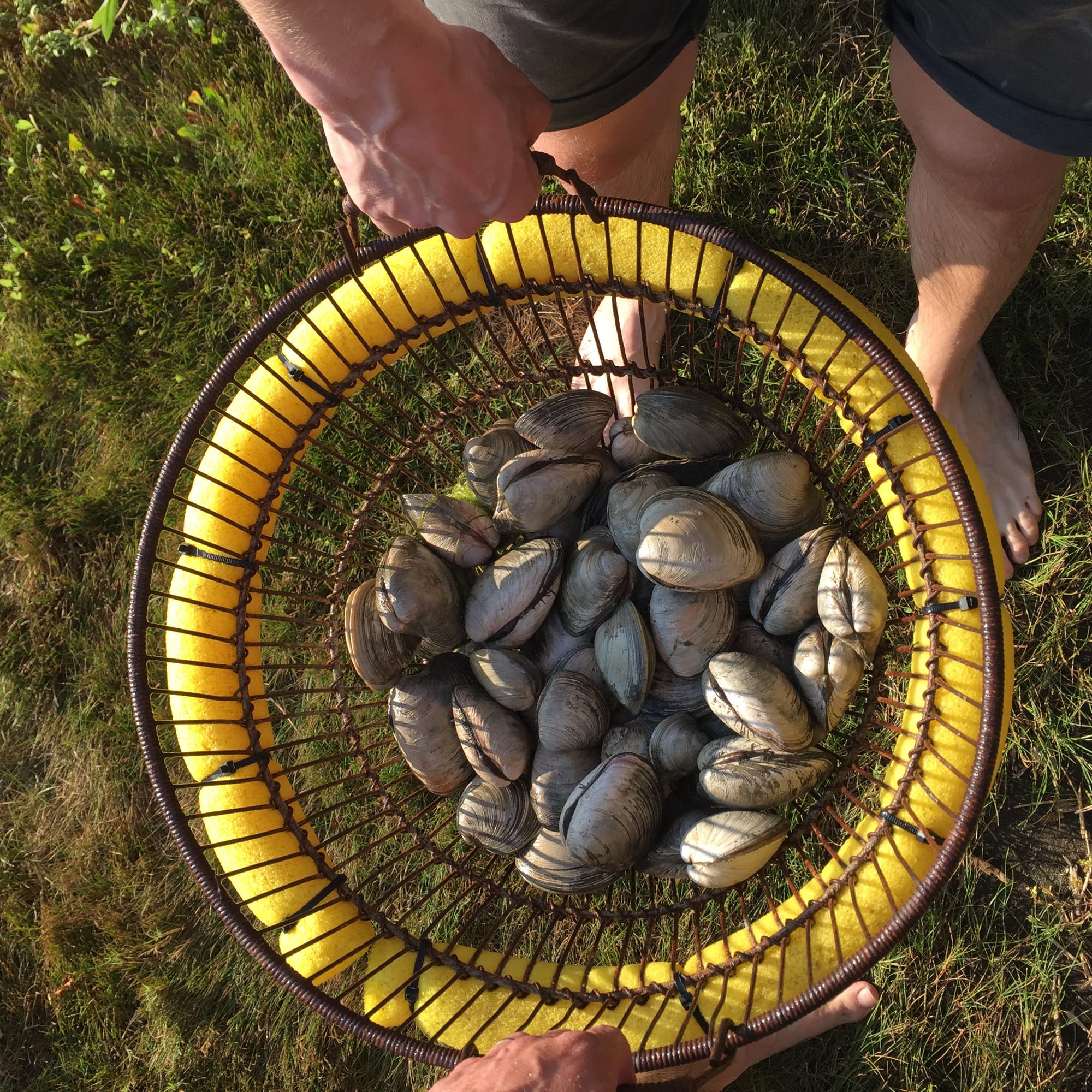
my best friends are clams
and I feel great about that
This week I finally cooked my first dinner for a few friends in the new apartment. This should have been a purely joyful and relaxing occasion, but a thing I love to do is attach unnecessary significance to an event, i.e. WHAT AM I GOING TO MAKE AS *THE FIRST MEAL* IN THIS NEW SPACE, THIS WILL SET THE TONE IT MUST BE FLAWLESS IF THIS DINNER IS NOT SPECIAL THIS WHOLE APARTMENT AND EVERYTHING I MAKE INSIDE IT WILL BE A FAILURE, which poisons the entire experience with so much anxiety, I wonder why I do it in the first place and should we just order in? Welcome to hell!
I decided to maybe not do that to myself this time and simply make something I was craving on a deep, cellular level. I decided that would be great, it would be perfect, it would be “enough”. That thing of course was pasta, but more specifically, clam pasta.
Clams and I have a gorgeous connection, an inexplicable energy that binds us. I wouldn’t call it a friendship, but I also might. A one-sided friendship, sure, as clams being mollusks probably have limited awareness of me, Alison Roman, a human. That said, we do have a lot in common. We both love salty water, spending time in the sand, and drowning ourselves in a crisp, dry verdejo. We’re both very into hanging out with large pots of pasta but also feel confident all by ourselves, showered in parsley and squeezed with lemon. We feel as comfortable at restaurants as we do at home.
I also love Clams for our differences— they’re undeniably more flexible and forgiving than I am, and their generosity truly knows no bounds. They give so much more than they ask for, exchanging uniquely bright, salty, briny liquor for only a cup of wine and some toasted garlic. What a trade-off.
It’s a bit of a fucked up dynamic though because as much as I love them and am grateful for all they do, I’m also obsessed with eating them. If they’re on a menu, I’m ordering them, if I can find them at a seafood market, I’m buying them and if I’m somewhere where they’re buried just below the surface of some muddy sand, I’m digging for them. I enjoy them cooked every way possible (steamed, grilled, ceviche’d, pasta’d, toast’d) and will argue to anyone who will listen that raw, they are better than even the best oyster.
Anyway. Clam pasta. I say clam pasta instead of linguini and clams because sometimes I like to do things like add sausage or chorizo to the clams and maybe use a shape like spaghetti. Keeping the name loose and vague manages expectations and allows for interpretation/evolution, but know that at its core it’s pasta cooked in clam broth. Linguini and clams, linguini alla vongole, whatever name you’d like to call it by.
I’ve made a version of clam pasta approximately eighteen thousand times, almost always in the summer months, during my anual 120-day shellfish challenge I give myself (how much shellfish CAN I eat from June to September without feeling the effects of my mild allergy? Tune in September 30th to find out). There’s never a recipe involved, not mine or someone else’s, no measurements or notes taken and once you feel comfortable, I encourage you to do the same.
It always starts the same: lots of olive oil and garlic (sliced, never chopped). Sometimes there’s a shallot, maybe a fennel bulb for sweetness. I’ve added spicy Italian sausage or fresh chorizo for extra fattiness and heat. Almost always a lemon (there she is!), either whole (sliced, chopped) or just the peel, finely chopped with the remains served on the side for juicing over. Definitely white wine (cheap, dry, and drinkable) and parsley (finely chopped and stirred into the pasta at the end, scattered over individual bowls for serving). When I’m feeling ambitious, I’ll toast some breadcrumbs for topping, a totally unnecessary but delightful addition that provides crunchiness until they’re doused in salty clam broth.
Each time I make it it’s different. Adjusting with more or less garlic based on what I have, an extra splash of wine here and there, adding other ingredients if they show up. No matter what, I feel safe knowing that if the clams are involved, giving up all they’ve got, my pasta cook in their liquid and it will be perfect (a compliment more to the clams, less so to me).
Over time, you too will see that clam pasta is less about precision, more about a feeling. A connection, a completely deranged and absolutely one-sided friendship. And it’s beautiful.


Click HERE for a printable PDF.
CLAM PASTA with toasted breadcrumbs
serves 4
Not unlike shrimp scampi, the excellence of this recipe depends on a saucy, brothy, garlicky wine sauce that should be good enough to drink on its own before adding your extremely al dente pasta to finish cooking in said sauce. The main difference between scampi and this though is A. there is no butter here and B. the clams are giving you a LOT of liquid (shrimp only take— something to think about!), which you can truly flavor however you like. I’m partial to the raw and toasted garlic with lemon, but you could go chili flake and shallot, add a chopped fennel bulb, maybe even start the clams with some sausage. Whether you stick to this recipe or go off on your own journey, just remember to make sure the clams are rinsed to the best of your ability (can’t pick sand out of pasta). Oh, and you may notice there’s no pasta water reserved: congratulations, you don’t need it! There should be more than enough clam juice in the pot to do the job.
Ingredients
- 3–4 pounds small clams, such as littlenecks, manilla or new zealand*
- ⅓ cup olive oil, plus more for drizzling
- ¾ cup coarse bread crumbs or panko
- Kosher salt, freshly ground black pepper
- Crushed red pepper flakes
- 10 cloves garlic, 8 thinly sliced, 2 grated
- 1 lemon, halved and peel finely chopped
- 1 cup dry white wine such as verdejo or pinot grigio
- 1 pound linguini, fettucini or spaghetti
- 1 cup finely chopped parsley or chives
Preparation
1. Wash the clams well under cold running water, paying special attention to the hinge where the two shells meet (that’s where most of the dirt/sediment sticks). If the clams are very fresh or look especially dirty, you can place them in a large bowl of cold water and let them soak for an hour or two so they can filter out the sand/sediment (not always necessary, but I like to if I can think to plan ahead).
2. Set a large pot of salted water on to boil.
3. Meanwhile, heat half the olive oil in another large pot (or skillet) over medium–high heat. Add bread crumbs and season with salt and pepper. Cook, tossing occasionally until they’re well toasted and evenly browned, 3–5 minutes. Add as much crushed red pepper flakes as you’d like and remove from heat. Transfer them to a small bowl and set aside.
4. Wipe the pot or skillet from any lingering crumbs, then add remaining olive oil over medium–high heat. Add sliced garlic and cook, stirring occasionally until the garlic is lightly browned, 2–3 minutes. Add chopped lemon peel and let it fry in the garlic oil for about 30 seconds. Add the white wine and clams, season with a little salt, and bring to a simmer. Cook uncovered, only shaking the pot occasionally, letting the clams steam open inside, 8–12 minutes (this will take longer with larger or thicker-shelled clams).
5. Using a slotted spoon, transfer the clams to a large bowl, leaving any liquid behind (any clams that came out of the shells can stay behind, too-- you’re just trying to remove the shells).
6. Meanwhile, boil the pasta until right before al dente (this step is important! It should be not quite cooked through because you’ll continue to cook it in the clam broth you’ve just made).
7. Drain the pasta (or simply lift the pasta from the pot using tongs). Add the pasta to the clam liquid and bring to a simmer. Cook for 4–6 minutes, occasionally tossing with your tongs to make sure all the pasta is getting even attention from the liquid and encouraging the sauce to thicken.
8. Taste a pasta strand and make sure it’s well seasoned and cooked through, adding more salt or pepper as needed. Add grated garlic to the pot and stir to combine. Add the clams back to the pot along with half the parsley and toss to coat. Transfer to a serving bowl and top with remaining parsley, a drizzle of olive oil, and the juice from the halved lemon. Serve with toasted breadcrumbs.
*I say 3–4 pounds because the smaller, thin-shelled clams like manilla or new zealand have thinner shells and you’ll need fewer (closer to 3 pounds). I find the littlenecks to be very heavy so I tend to compensate and get closer to 4 pounds.
For the month of July, a portion of profits from paid subscriptions will go to, Feeding America, an organization working to provide meals and groceries to those who need it most. Learn more about them here.
Past supported organizations to put on your radar: The Okra Project / Food Issues Group / La Cocina / Heart of Dinner / ACLU / FAIR FIGHT / Feeding America / Restaurant Workers Community Foundation / For The Culture / Welcome to Chinatown / Star Route Farm / City Harvest


Discussion